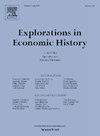肯尼亚的殖民遗产与财富不平等
IF 1.7
1区 历史学
Q1 ECONOMICS
引用次数: 0
摘要
本文讨论了 20 世纪 50 年代末至今肯尼亚财富分配的演变。文章利用以前尚未开发的遗嘱检验和行政管理资料来源,测量了肯尼亚人死后留下遗产的比例,并描绘了这一财富拥有阶层随着时间的推移发生的变化。报告显示,非洲人的遗产在独立后有所增长,到 20 世纪 80 年代,大约有 8% 的肯尼亚人在死后留下了遗产,这在很大程度上是土地所有权和土地改革的结果。与此同时,欧洲人的庄园随着定居者的撤资而减少。自 20 世纪 90 年代以来,以内罗毕为基地的遗产持有者所占比例不断增加,这反映出城市房地产在富人投资组合中的重要性。对最高财富份额的衡量表明,在殖民地晚期和现在,财富不平等现象都很严重,但今天的财富不平等是由住房财富的不均衡分配造成的,而不是由农业用地造成的。这些发现说明了各种殖民遗产如何影响后殖民时期肯尼亚的财富积累。本文章由计算机程序翻译,如有差异,请以英文原文为准。
Colonial legacies and wealth inequality in Kenya
This article discusses the evolution of Kenya's wealth distribution from the late 1950s to the present. Utilizing previously untapped probate and administration sources, it measures the share of Kenyans leaving estates at death, and maps how this wealth-owning strata has changed over time. It shows a growth in African estates after independence, and by the 1980s roughly 8 % of Kenyans left estates at death, largely a consequence of land titling and land reform. Meanwhile, European estates dwindled as settlers divested. Since the 1990s, Nairobi-based estate-holders are growing in share, reflecting the importance of urban property to the portfolios of the wealthy. Measures of top wealth shares suggest high wealth inequality in both the late colonial period and the present, but today's wealth inequality is driven by the uneven distribution of housing wealth, more so than by agricultural land. These findings illustrate how a variety of colonial legacies influenced wealth accumulation in postcolonial Kenya.
求助全文
通过发布文献求助,成功后即可免费获取论文全文。
去求助
来源期刊

Explorations in Economic History
Multiple-
CiteScore
2.50
自引率
8.70%
发文量
27
期刊介绍:
Explorations in Economic History provides broad coverage of the application of economic analysis to historical episodes. The journal has a tradition of innovative applications of theory and quantitative techniques, and it explores all aspects of economic change, all historical periods, all geographical locations, and all political and social systems. The journal includes papers by economists, economic historians, demographers, geographers, and sociologists. Explorations in Economic History is the only journal where you will find "Essays in Exploration." This unique department alerts economic historians to the potential in a new area of research, surveying the recent literature and then identifying the most promising issues to pursue.
 求助内容:
求助内容: 应助结果提醒方式:
应助结果提醒方式:


